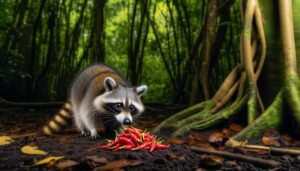Do Raccoons Like to Cuddle and How to Understand Their Affection?
Raccoons exhibit a range of affectionate behaviors, including cuddling, particularly within family units and among siblings. These behaviors play a significant role in social bonding, stress reduction, and cooperative survival strategies.
Mutual grooming, nuzzling, and physical closeness are common, especially between mother raccoons and their offspring. These interactions help in parasite control and reinforce social connections.
In urban environments, raccoons may show some affectionate behaviors towards humans, particularly when accustomed to regular feeding. To better understand the complexities of raccoon social behaviors and their interactions with both conspecifics and humans, further study is essential.
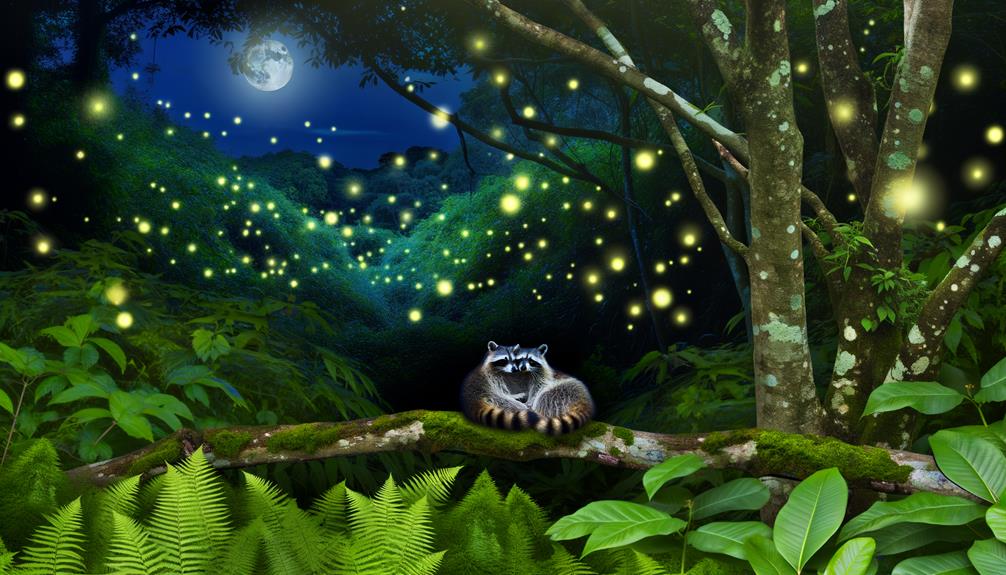
Key Takeaways
- Raccoons exhibit cuddling behaviors through nuzzling, light grooming, and snuggling to strengthen social bonds.
- Physical closeness and mutual grooming among raccoons help in maintaining group cohesion.
- Mother-infant bonding involves constant grooming and close physical contact.
- Raccoons rest together to share body warmth, indicating a preference for physical closeness.
- Affectionate behaviors like gentle touch reduce stress and enhance social interactions among raccoons.
Raccoon Social Structure
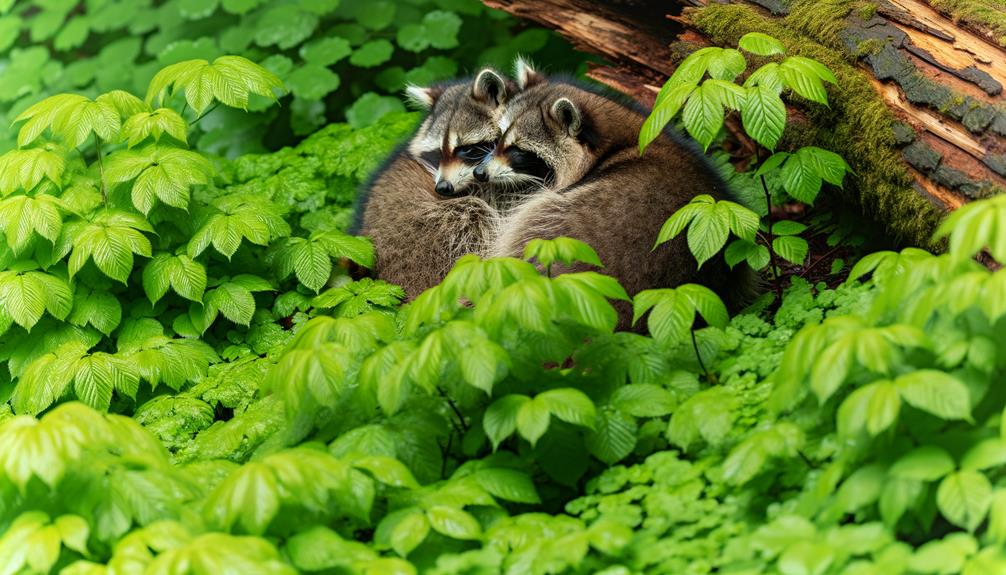
Raccoon social structure is characterized by a complex system of interactions that vary based on age, gender, and environmental factors. Adult males tend to be solitary, establishing territories that overlap with several females.
Females exhibit strong maternal behaviors, often forming small family units with their offspring until they are independent. Juveniles may stay with their mother for up to a year, learning essential survival skills.
Seasonal changes influence raccoon behavior; during breeding seasons, social interactions increase, whereas winter months see reduced activity as raccoons enter a state of torpor.
Research indicates that resource availability, such as food and shelter, profoundly impacts these social dynamics, leading to fluid and adaptive social structures among raccoon populations.
Affectionate Behaviors
Affectionate behaviors in raccoons manifest primarily through social bonding displays and gentle touch preferences. Observations indicate that raccoons engage in mutual grooming and physical proximity to strengthen social ties within their groups.
Additionally, raccoons exhibit a preference for soft, non-aggressive interactions, suggesting a nuanced approach to tactile communication.
Social Bonding Displays
Engaging in mutual grooming and physical closeness are common social bonding displays observed among raccoons, indicating their capacity for affectionate behaviors. Studies have documented raccoons grooming each other's fur, which not only helps in parasite control but also strengthens social bonds within the group.
Physical proximity is another indicator; raccoons often rest and sleep together, particularly in colder climates, to share body warmth. These behaviors suggest that raccoons employ tactile interaction as a means of reinforcing social connections.
Observations in both wild and captive settings support these findings, highlighting that these social bonding displays are consistent across different environments. Hence, raccoons' affectionate behaviors are essential for maintaining social structures and ensuring group cohesion.
Gentle Touch Preferences
Evidence from ethological studies indicates that raccoons exhibit a distinct preference for gentle touch as a form of affectionate behavior, which plays a pivotal role in their social interactions. This behavior includes nuzzling, light grooming, and gentle pawing, often observed between mother raccoons and their offspring, as well as among adult raccoons in social groups. The following table summarizes key findings on raccoon gentle touch preferences:
| Behavior | Description |
|---|---|
| Nuzzling | Softly rubbing noses or faces |
| Light Grooming | Using paws or mouth to clean fur |
| Gentle Pawing | Lightly touching each other with paws |
| Snuggling | Curling up closely together |
These behaviors facilitate bonding, stress reduction, and group cohesion, underscoring their importance in raccoon social dynamics.
Mother-Infant Bonding
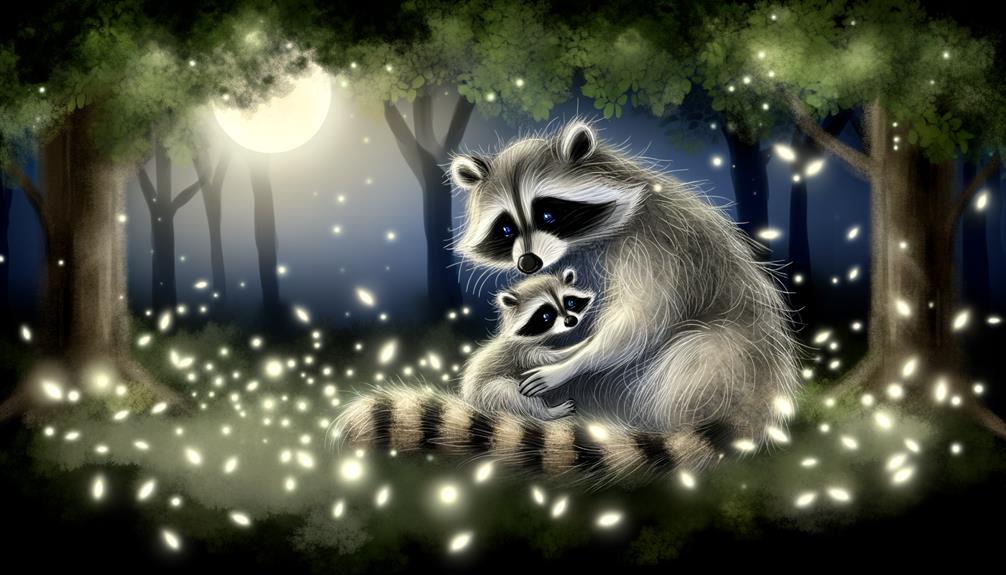
Mother-infant bonding in raccoons is critical for the survival and development of the offspring. Maternal behaviors, such as constant grooming and close physical contact, exhibit protective instincts and facilitate early life bonding.
These nurturing behavior patterns play a significant role in the cognitive and social development of the young raccoons.
Early Life Bonding
How does the early life bonding between raccoon mothers and their offspring influence their social behaviors and survival strategies?
Early life bonding plays an essential role in shaping raccoon social behaviors and survival mechanisms. This bonding period ensures the transfer of necessary skills and behaviors from mother to offspring, impacting their adaptability and interaction within their environment.
Key influences include:
- Nurturing and Care: Mother raccoons provide warmth and protection, fostering a sense of security.
- Skill Transmission: Offspring learn crucial survival skills such as foraging and predator avoidance.
- Social Structure Development: Early bonding influences social hierarchy and group dynamics.
- Behavioral Adaptation: Strong early bonds contribute to adaptability and resilience in varying environments.
These factors collectively enhance the offspring's chances of survival and successful integration into raccoon society.
Protective Maternal Instincts
The protective maternal instincts in raccoons are essential, ensuring the safety and development of their offspring during the vulnerable stages of early life. Female raccoons exhibit strong guarding behaviors, often relocating their kits to multiple dens to avoid predators. These relocations can occur every few days, particularly during the first six weeks when kits are most susceptible.
Studies indicate that maternal raccoons spend approximately 90% of their time with their young during the initial weeks postpartum, providing warmth and nourishment. Additionally, maternal vocalizations play a vital role in maintaining contact with the kits.
This innate protective behavior highlights the significant role of maternal care in raccoon survival, showcasing the species' evolutionary adaptations for offspring protection.
Nurturing Behavior Patterns
In raccoons, nurturing behaviors are characterized by close physical contact, grooming, and continuous vocal communication between the mother and her kits. These behaviors are crucial for the development and survival of the young. Scientific observations have identified key aspects of this bonding process:
- Physical Contact: Mothers frequently keep their kits close, often carrying them by the scruff to guarantee their safety.
- Grooming: Regular grooming by the mother helps maintain the hygiene of the kits and strengthens their social bonds.
- Vocal Communication: Continuous vocalizations, including purring and chirping, facilitate bonding and coordination between mother and kits.
- Feeding: The mother provides sustenance through nursing, ensuring the kits receive essential nutrients for growth.
These behaviors exemplify the intricate maternal care in raccoons.
Sibling Interactions
Among raccoon siblings, interactions often include playful wrestling and grooming behaviors which are crucial for social bonding and development. These activities serve multiple functions: they enhance motor skills, establish social hierarchies, and facilitate emotional connections. Studies indicate that sibling play reduces stress and increases resilience to environmental challenges.
Grooming, observed frequently among raccoon siblings, promotes hygiene and reinforces affiliative bonds. Data from ethological observations highlight that these interactions peak during the early months of life, gradually decreasing as juveniles mature. Importantly, sibling groups display higher cohesion and cooperative behaviors compared to solitary juveniles, underscoring the importance of early social interactions.
Adult Raccoon Dynamics

Adult raccoons exhibit a complex array of social behaviors that vary significantly depending on environmental factors and resource availability. These behaviors include solitary and social interactions, which can be influenced by the need for food, shelter, and mating opportunities.
Research has identified that adult raccoons demonstrate:
- Territoriality: Males tend to establish and defend territories, especially during mating season.
- Gregariousness: Females, particularly those with offspring, may form loose social groups to enhance survival.
- Nocturnal Activity: Raccoons are primarily nocturnal, which impacts their social dynamics and interactions.
- Resource-driven Behavior: Access to food and water sources can lead to temporary aggregations, affecting social structures.
These behaviors are essential for understanding raccoon ecology and managing human-wildlife interactions effectively.
Raccoons in the Wild
In the wild, raccoons exhibit distinct nocturnal behavior patterns. They primarily forage for food under the cover of darkness. Observational studies indicate that while raccoons are generally solitary animals, they do engage in social interactions. This is particularly evident during the breeding season and when raising offspring.
Quantitative data on these interactions provide insights into their social structure and communication methods.
Nocturnal Behavior Patterns
Raccoons exhibit distinct nocturnal behavior patterns, primarily foraging and engaging in social interactions under the cover of darkness. This nocturnality is an adaptive trait that minimizes predation risks and optimizes food resource availability.
Key behaviors include:
- Foraging: Raccoons use their dexterous front paws to search for food, often near water sources, where they consume invertebrates, small vertebrates, and plant matter.
- Territoriality: They establish and defend territories, which they mark with scent glands located on their feet and tail.
- Denning: Raccoons seek out secure dens in tree hollows, burrows, or man-made structures to rest during daylight hours.
- Communication: Nocturnal vocalizations and scent markings serve as primary communication methods among individuals.
Understanding these behaviors provides insight into their ecological roles and adaptive strategies.
Social Interactions Observed
Observations of raccoon social interactions in wild settings reveal complex behaviors that extend beyond the isolated foraging and territoriality typically associated with their nocturnal activities. Studies indicate that raccoons exhibit a range of affiliative behaviors, particularly among family groups. Females and their young often display grooming behaviors, vocal communications, and coordinated movements, suggesting a level of social cohesion.
During the breeding season, males may temporarily form loose associations, although these interactions are generally competitive. Data collected from field observations and camera traps have documented instances of raccoons sharing dens and resources, underscoring their capacity for social flexibility.
Therefore, while primarily solitary, raccoons demonstrate significant social interactions that are essential for survival and reproductive success in their natural habitats.
Raccoon Communication

Frequently, raccoons utilize a complex array of vocalizations, body language, and scent markings to communicate with each other. These communication methods are essential for their social interactions and survival.
Research has identified several key components of raccoon communication:
- Vocalizations: Raccoons produce over 200 distinct sounds, including purrs, growls, and screams, each serving different social functions.
- Body Language: Tail positions, facial expressions, and postures indicate emotions and intentions, such as aggression or submission.
- Scent Markings: Glands near their anus and feet secrete chemicals used for marking territory and identifying individuals.
- Tactile Communication: Physical contact, such as grooming and playful wrestling, strengthens social bonds and hierarchies within groups.
These elements collectively facilitate intricate interactions among raccoons, ensuring cohesive group dynamics and successful foraging.
Human-Raccoon Interaction
Given their complex communication methods, understanding human-raccoon interactions requires examining how these animals perceive and respond to human presence. Research indicates that raccoons exhibit a variety of behaviors when encountering humans, often influenced by prior experiences and environmental context.
Studies show that raccoons in urban areas, accustomed to human activity, display reduced fear responses compared to their rural counterparts. Behavioral observations suggest that raccoons may approach humans if food is anticipated, yet they maintain a cautious distance. When raccoons can exhibit curiosity and occasional affiliative behaviors, these interactions are largely driven by opportunistic feeding rather than genuine social bonding.
Consequently, their responses are more practical than affectionate, reflecting a survival-oriented adaptation to human environments.
Domesticated Raccoons
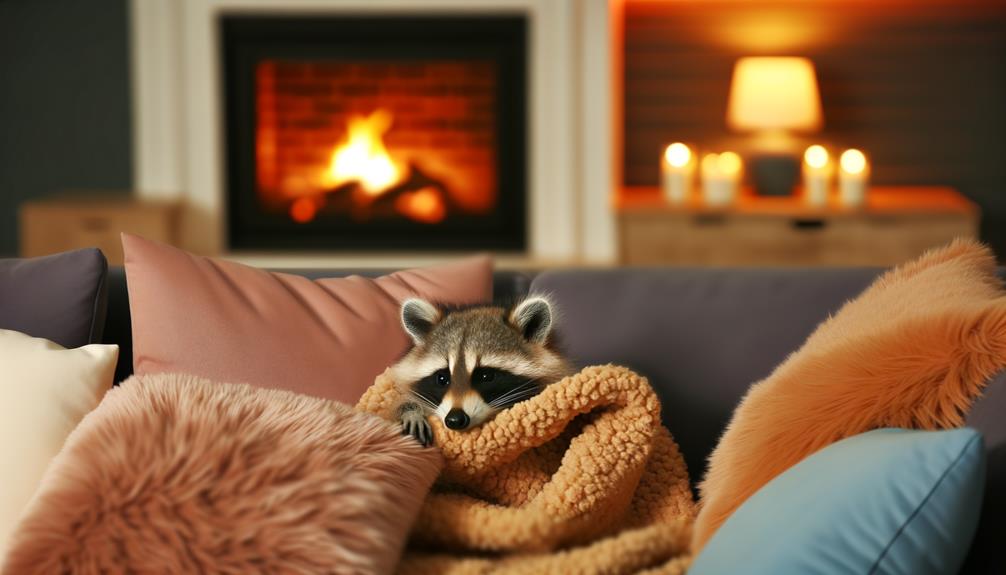
While raccoons are not traditionally domesticated animals, some individuals have kept them as pets, leading to unique behavioral studies and observations. Domesticated raccoons exhibit distinct patterns that differ from their wild counterparts. Key findings from these observations include:
- Attachment to Owners: Domesticated raccoons often form strong bonds with their caregivers, displaying signs of attachment similar to that seen in domestic dogs and cats.
- Social Interactions: They engage in playful behaviors and social interactions more frequently when in a safe, controlled environment.
- Adaptability: Raccoons show a significant ability to adapt to household routines and environments, learning from human behavior.
- Health and Diet: Their dietary needs remain consistent with wild raccoons, requiring a balanced diet to prevent malnutrition and obesity.
These insights provide a deeper understanding of raccoon behavior in domestic settings.
Behavioral Studies
Behavioral studies on raccoons provide valuable insights into their cognitive abilities, social structures, and adaptability to various environments.
Research has demonstrated that raccoons exhibit advanced problem-solving skills, often outperforming other mammals in tasks that require memory and manipulation.
Socially, raccoons are generally solitary but can exhibit cooperative behaviors, especially in urban settings where resources are abundant.
Studies also highlight their remarkable adaptability; raccoons have successfully colonized diverse habitats, from rural woodlands to metropolitan areas.
Their ability to thrive in varied environments underscores their behavioral plasticity.
Data from field observations and controlled experiments contribute significantly to our understanding of raccoon behavior, enabling better management strategies for human-wildlife interactions and conservation efforts.
Expert Opinions
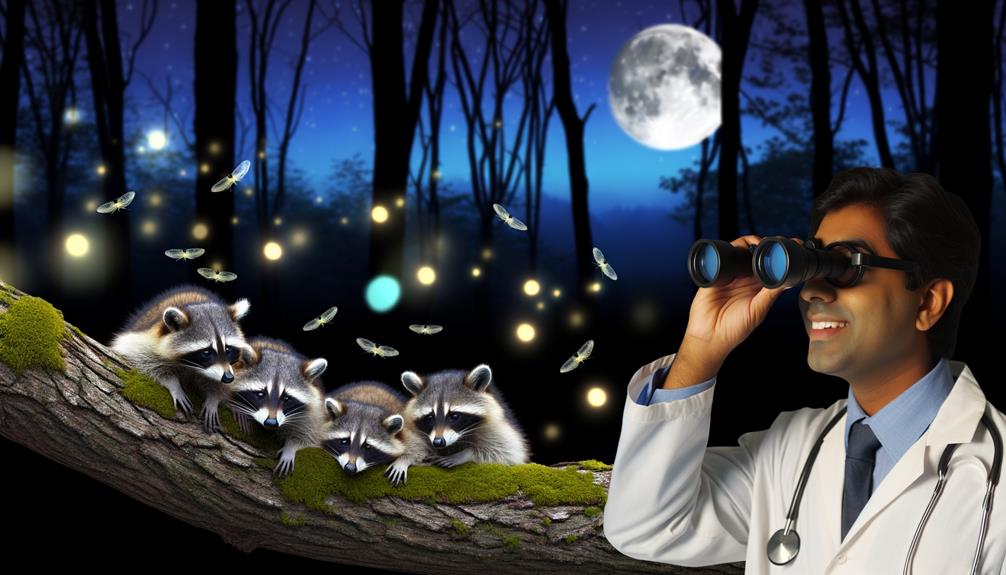
Experts in the field of wildlife biology provide nuanced perspectives on raccoon behavior, particularly regarding their social interactions and affinity for physical closeness. While raccoons are generally solitary animals, certain expert observations highlight conditions under which they might exhibit cuddliness:
- Seasonal Variation: During colder months, raccoons may huddle together for warmth, demonstrating temporary physical closeness.
- Maternal Behavior: Mother raccoons are known to exhibit nurturing behaviors, including grooming and close physical contact with their offspring.
- Habituation to Humans: In instances where raccoons have become accustomed to human presence, some may show a greater tolerance for physical interaction.
- Captive Environments: Raccoons in rehabilitation or sanctuary settings sometimes display more social behaviors due to controlled conditions and consistent care.
These observations provide a balanced understanding of raccoon social behavior and physical interactions.
Conclusion
Raccoon social behavior is characterized by intricate affectionate interactions. This uncovers a tapestry of bonding from mother-infant connections to sibling camaraderie and adult dynamics.
Human-raccoon interactions and studies of domesticated raccoons underscore their complex emotional capacities. Behavioral research, akin to peeling back layers of an onion, uncovers the nuanced social fabric of these creatures.
Expert opinions and empirical data collectively illuminate the multifaceted nature of raccoon companionship, challenging simplistic notions and inviting further exploration into their social lives.






